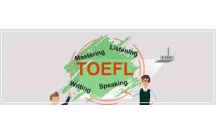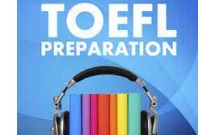
Bài mẫu Reading của TOEFL - bài 4
TOEFL Reading Comprehension Lesson 4
Đ c đo n văn sau và tr l i các câu h i:ọ ạ ả ờ ỏ
A pilot cannot fly a plane by sight alone. In many conditions, such as flying at night and
landing in dense fog, a pilot must use radar, an alternative way of navigating. Since
human eyes are not very good at determining speeds of approaching objects, radar can
show a pilot how fast nearby planes are moving.
The basic principle of radar is exemplified by what happens when one shouts in a cave.
The echo of the sounds against the walls helps a person determine the size of the cave.
With radar, however, the waves are radio waves instead of sound waves. Radio waves
travel at the speed of light, about 300,000 kilometers in one second. A radar set sends out
a short burst of radiation waves. Then it receives the echoes produced when the waves
bounce off objects. By determining the time it takes for the echoes to return to the radar
set, a trained technician can determine the distance between the radar set and other
objects. The word “radar,” in fact, gets its name from the term “radio detection and
ranging.” “Ranging” is the term for detection of the distance between an object and the
radar set. Besides being of critical importance to pilots, radar is essential for air traffic
control, tracking ships at sea, and for tracking weather systems and storms.
1. What is the main topic of this passage?
A. the nature of radar
B. types of ranging
C. alternatives to radar
D. history of radar
2. In line 2, the word “dense” could be replaced by
A. Cold
B. Wet
C. Dark
D. Thick
3. According to the passage, what can radar detect besides location of objects?
A. size
B. Weight
C. Speed
D. Shape
4. The word “shouts” in line 5 is most similar in meaning to which of the following?
A. Eavesdrops
B. Yells
C. Confesses
D. Whispers
5. Which of the following words best describes the tone of this passage?
A. Argumentative
B. Imaginative
C. Explanatory
D. Humorous
6. The phrase “a burst” in line 9 is closest in meaning in which of the following?
A. an attachment
B. a discharge
C. a stream
D. a ray
7. The word “it” in line 9 refers to which of the following?
A. a radar set
B. a short burst
C. a radiation wave
D. light
8. Which of the following could best replace the word “bounce” in line 10?
A. Overturn
B. Groove
C. Extend
D. Rebound
9. Which type of waves does radar use?
A. Sound
B. Heat
C. Radio
D. Light
10. The word “tracking” in line 15 is closest in meaning to which of the following?
A. repairing
B. searching for
C. glancing at
D. fighting
11. Which of the following would most likely be the topic of the next paragraph?
A. other uses of radar
B. uses of sonar technology
C. other technology used by pilots
D. a history of flying
12. What might be inferred about radar?
A. It takes the place of a radio.
B. It gave birth to the invention of the airplane.
C. It developed from a study of sound waves.
D. It has improved navigational safety.
ĐÁP ÁN
1. A
2. D
3. C
4. B
5. C
6. B
7. A
8. D
9. C
10. B
11. A
12. D
có thể bạn quan tâm

Bài mẫu Reading của TOEFL - bài 1
3
1.596
473
Luyện thi TOEFL
3
(New)

Bài mẫu Reading của TOEFL - bài 2
3
1.317
484
Luyện thi TOEFL
3
(New)

Bài mẫu Reading của TOEFL - bài 3
3
1.320
515
Luyện thi TOEFL
3
(New)

Bài mẫu Reading của TOEFL - bài 5
3
5.362
543
Luyện thi TOEFL
3
(New)

Bài mẫu Reading của TOEFL - bài 6
3
1.419
535
Luyện thi TOEFL
3
(New)

Bài mẫu Reading của TOEFL - bài 7
4
1.891
598
Luyện thi TOEFL
4
(New)

Một bài thi TOEFL iBT sẽ diễn ra như thế nào
7
1.367
385
Luyện thi TOEFL
7
(New)

TOEIC Reading - một số bài thi thử có đáp án
0
2.433
613
Luyện Thi TOEIC
(New)
thông tin tài liệu
Bài mẫu Reading của TOEFL - bài 4
The basic principle of radar is exemplified by what happens when one shouts in a cave. The echo of the sounds against the walls helps a person determine the size of the cave. With radar, however, the waves are radio waves instead of sound waves. Radio waves travel at the speed of light, about 300,000 kilometers in one second. A radar set sends out a short burst of radiation waves. Then it receives the echoes produced when the waves bounce off objects. By determining the time it takes for the echoes to return to the radar set, a trained technician can determine the distance between the radar set and other objects. The word “radar,” in fact, gets its name from the term “radio detection and ranging.” “Ranging” is the term for detection of the distance between an object and the radar set. Besides being of critical importance to pilots, radar is essential for air traffic control, tracking ships at sea, and for tracking weather systems and storms.
1. What is the main topic of this passage?
A. the nature of radar
B. types of ranging
C. alternatives to radar
D. history of radar
Mở rộng để xem thêm
từ khóa liên quan
tài liệu mới trong mục này
tài liệu hot trong mục này
tài liệu giúp tôi
Nếu bạn không tìm thấy tài liệu mình cần có thể gửi yêu cầu ở đây để chúng tôi tìm giúp bạn!
×



